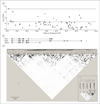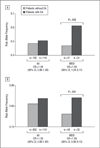Association of genetic variants in the neurotrophic receptor-encoding gene NTRK2 and a lifetime history of suicide attempts in depressed patients
- PMID: 20124106
- PMCID: PMC3696349
- DOI: 10.1001/archgenpsychiatry.2009.201
Association of genetic variants in the neurotrophic receptor-encoding gene NTRK2 and a lifetime history of suicide attempts in depressed patients
Abstract
Context: A consistent body of evidence supports a role of reduced neurotrophic signaling in the pathophysiology of major depressive disorder (MDD) and suicidal behavior. Especially in suicide victims, lower postmortem brain messenger RNA and protein levels of neurotrophins and their receptors have been reported.
Objective: To determine whether the brain-derived neurotrophic factor (BDNF) gene or its high-affinity receptor gene, receptor tyrosine kinase 2 (NTRK2), confer risk for suicide attempt (SA) and MDD by investigating common genetic variants in these loci.
Design: Eighty-three tagging single-nucleotide polymorphisms (SNPs) covering the genetic variability of these loci in European populations were assessed in a case-control association design.
Setting: Inpatients and screened control subjects.
Participants: The discovery sample consisted of 394 depressed patients, of whom 113 had SA, and 366 matched healthy control subjects. The replication studies comprised 744 German patients with MDD and 921 African American nonpsychiatric clinic patients, of whom 152 and 119 were positive for SA, respectively.
Interventions: Blood or saliva samples were collected from each participant for DNA extraction and genotyping.
Main outcome measures: Associations of SNPs in BDNF and NTRK2 with SA and MDD.
Results: Independent SNPs within NTRK2 were associated with SA among depressed patients of the discovery sample that could be confirmed in both the German and African American replication samples. Multilocus interaction analysis revealed that single SNP associations within this locus contribute to the risk of SA in a multiplicative and interactive fashion (P = 4.7 x 10(-7) for a 3-SNP model in the combined German sample). The effect size was 4.5 (95% confidence interval, 2.1-9.8) when patients carrying risk genotypes in all 3 markers were compared with those without any of the 3 risk genotypes.
Conclusions: Our results suggest that a combination of several independent risk alleles within the NTRK2 locus is associated with SA in depressed patients, further supporting a role of neurotrophins in the pathophysiology of suicide.
Figures



References
-
- World Health Organization. [Accessed November 18];Suicide prevention (SUPRE) http://www.who.int/mental_health/prevention/suicide/suicideprevent/en/in....
-
- Weissman MM, Bland RC, Canino GJ, Greenwald S, Hwu HG, Joyce PR, Karam EG, Lee CK, Lellouch J, Lepine JP, Newman SC, Rubio-Stipec M, Wells JE, Wickramaratne PJ, Wittchen HU, Yeh EK. Prevalence of suicide ideation and suicide attempts in nine countries. Psychol Med. 1999;29(1):9–17. - PubMed
-
- Kessler RC, Borges G, Walters EE. Prevalence of and risk factors for lifetime suicide attempts in the National Comorbidity Survey. Arch Gen Psychiatry. 1999;56(7):617–626. - PubMed
-
- Bostwick JM, Pankratz VS. Affective disorders and suicide risk: a reexamination. Am J Psychiatry. 2000;157(12):1925–1932. - PubMed
-
- Statham DJ, Heath AC, Madden PAF, Bucholz KK, Bierut L, Dinwiddie SH, Slutske WS, Dunne MP, Martin NG. Suicidal behaviour: an epidemiological and genetic study. Psychol Med. 1998;28(4):839–855. - PubMed
Publication types
MeSH terms
Substances
Grants and funding
LinkOut - more resources
Full Text Sources
Other Literature Sources

